In cotton farming, Integrated Pest Management (IPM) is the key to keeping pesky insects at bay while safeguarding our crops and the environment. The goal? To reduce the need for pesticides while maintaining healthy cotton plants that yield high-quality fibers. IPM isn’t just about pest control; it’s about nurturing our environment.
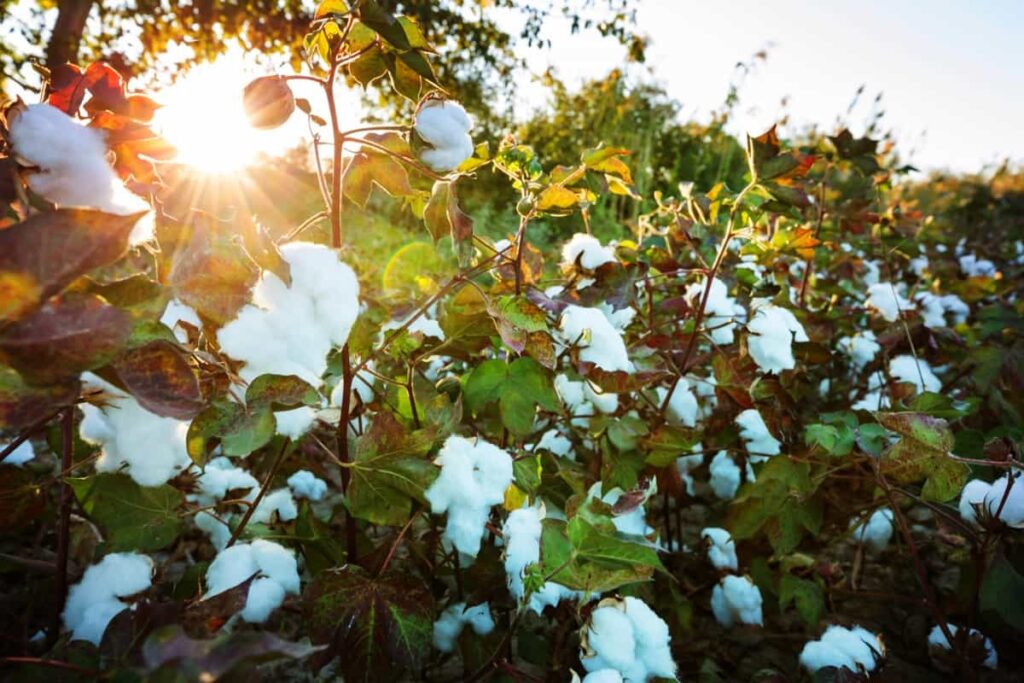
A successful IPM program is eco-friendly and paves the way for a well-rounded crop management approach. The beauty of IPM lies in its adaptability, always evolving to improve technical methods and patch up the chinks in our pest-fighting armor. It’s the sustainable way forward for cotton farming.
Introduction to Pest Management in Cotton Farming
In India, cotton cultivation occupies 5% of the total cropped land, distributed across three distinct agro-climatic zones. Shockingly, cotton farming consumes 55% of the nation’s pesticides, accounting for 40% of production costs. This alarming statistic underscores the escalating reliance on pesticides and the profound impact of insect pests on cotton production.
Despite 15 years of implementation of Integrated Pest Management (IPM), pesticide usage has yet to drop significantly. IPM, focusing on natural controls, cultural practices, resistant cultivars, monitoring, and alternative pest control methods, strives to mitigate the pest problem. But the challenge persists. Cotton faces threats from over 130 insect pest species in India, affecting its growth. Sucking pests such as jassids, aphids, whiteflies, and thrips negatively influence cotton development, potentially reaching alarming levels.
Moreover, the abundance of alternative hosts, including vegetables and wild plants, further sustains these pests. The bollworm complex, including Earias, Helicoverpa, and Pectinophora species, inflicts damage during the reproductive phase of cotton growth. Helicoverpa, in particular, has become a significant cotton bollworm. Lepidopterans and other pests add to the challenges.
Understanding Cotton Pest and Management
Pesticides play a crucial role in global crop protection but have significant drawbacks. Cotton farming constitutes a whopping 4.7% of worldwide pesticide usage and 10% of insecticide sales, surpassing land allocation. Highly Hazardous Pesticides (HHPs) pose severe risks to human health and the environment, with approximately 44% of farmers poisoned annually, leading to ailments like cancer and neurological disorders. Environmental damage includes water pollution and food contamination.
In case you missed it: High Yield Hybrid Cotton Varieties in India – For Rabi, and Kaharif Seasons
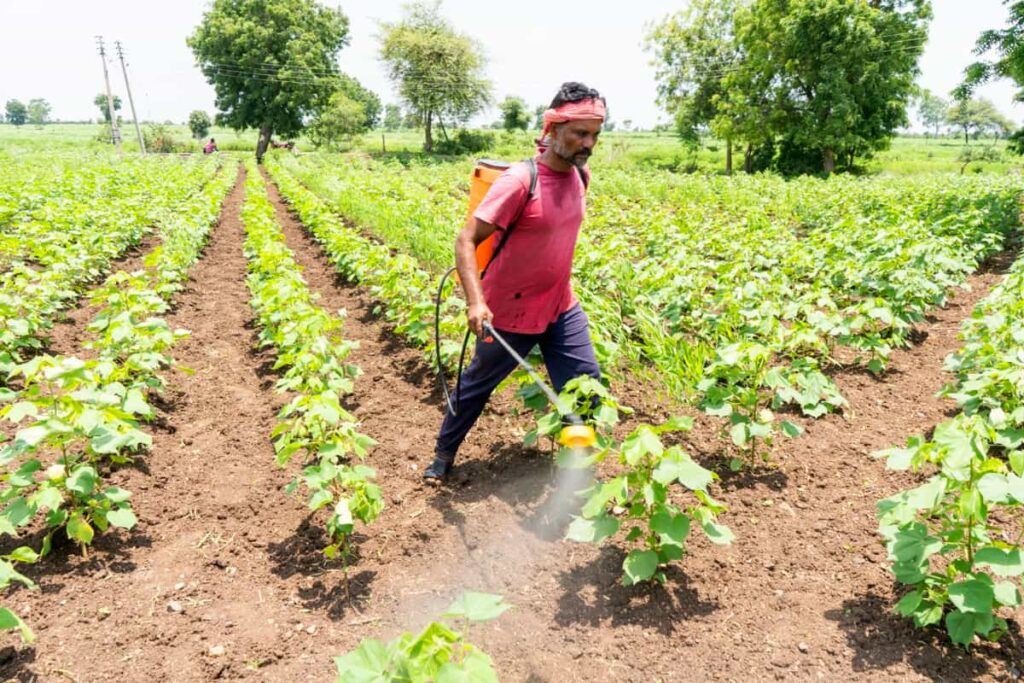
Cotton’s vulnerability to pests necessitates various protection methods, including pheromones, plant breeding, cultural techniques, mechanical measures, conventional pesticides, and genetically modified plants. Excessive pesticide use fosters resistance, disrupts beneficial insect populations, and triggers secondary pest outbreaks. The Better Cotton Initiative adopts an Integrated Pest Management (IPM) approach, prioritizing non-chemical solutions like biopesticides or traps.
They aim to reduce synthetic pesticide use by 50% by 2030. IPM focuses on healthy crops, pest prevention, beneficial organism preservation, field observations, and resistance management. While striving for non-chemical alternatives, farmers may opt for pesticides based on economic thresholds. The Initiative guides them on minimizing pesticide harm through proper practices and informed choices.
Identifying Common Cotton Pests
- Jassids (Amrasca biguttulla biguttulla): Jassids cause downward curling of cotton leaves, resulting in yellowing and hopper burn symptoms. These small insects feed on plant sap, leading to leaf damage.
- Aphids (Aphis gossypii): Aphids induce downward leaf curling and leave behind sticky honeydew deposits on cotton bolls. This honeydew can attract sooty mold and reduce cotton quality.
- Whiteflies (Bemisia tabaci): Infestations of whiteflies result in distorted and wrinkled leaves with shiny white patches. These insects sap plant nutrients, weakening cotton plants.
- Spotted and Spiny Bollworm (Earias vitellla and Earias insulana): These bollworms create boremarks in the main cotton shoot and feed on floral buds, often blocking them with excrement. This can lead to reduced cotton yield.
- American Bollworm (Helicoverpa armigera): Signs of American bollworm infestation include webbing on cotton squares, square damage, and excessive shedding of bolls and buds, impacting cotton production.
- Pink Bollworm (Pectinophora gossypiella): Pink bollworms cause rosette bolls with interloci movement, affecting cotton crop development and quality.
- SemiLooper (Anomis flava): Semi-loopers lead to significant loss of leaf area, potentially reducing cotton plant vigor and yield.
The Impact of Pests on Cotton Crops
- Cotton Dominance: India boasts 26% of the world’s cotton production and the largest cotton cultivation area (41%). However, cotton crops face severe threats.
- Vulnerability: Cotton is highly susceptible to pests, and this vulnerability contributes to uncertainties in yield and income for farmers, often pushing them into debt and despair.
- Bollworm Predicament: Bollworms are the primary culprits, responsible for 70% of pest damage. Among them, the Pink Bollworm (PBW) poses the greatest threat, having developed resistance to Bt-cotton.
- Smallholder Struggles: India has around 5.8 million cotton farmers, with over 75% being smallholders or landless, needing more resources for advanced pest management. Pesticide use remains high, but up to 30% of crops are lost to pests.
- Low Yields: India’s cotton yield stands at 487 kg/ha, significantly lower than the global average of 768 kg/ha, reflecting the challenges faced by Indian cotton growers.
- Limitations of Current Approaches: Existing pest control methods involve manual data collection, analysis, and advisory dissemination, which are error-prone, unverifiable, and difficult to scale. Timely action against PBW infestations is critical, making delays detrimental.
In case you missed it: Pests Affecting Tomato Crops at Flowering Stage: Symptoms, Control, and Prevention
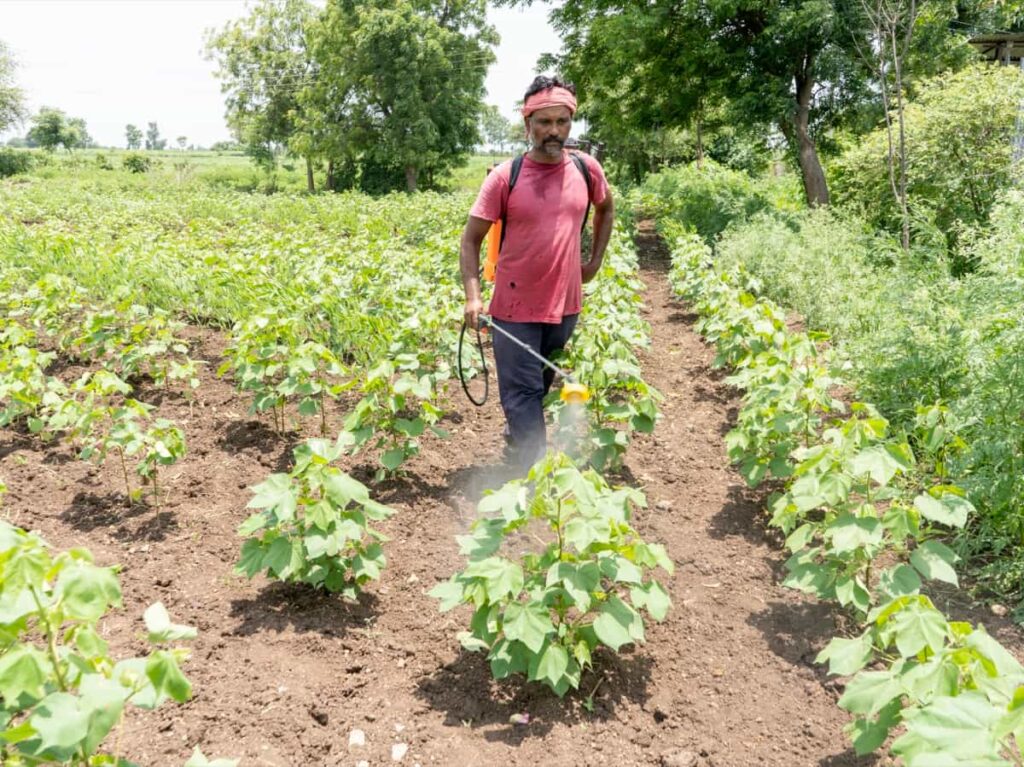
Integrated Pest Management (IPM) Strategies
Natural Control
- Predators: Native predators like Chilomenes sexmaculatus and Chrysoperla carnea are vital in controlling early-season sucking pests. A predator-prey ratio of 1.5 for jassids and 0.1 for aphids is optimal for natural control.
- Combination Strategy: To preserve natural enemies, avoiding broad-spectrum insecticides that harm these predators is essential. A strategy combining sucking pest-tolerant cotton genotypes with natural enemy exploitation is recommended.
Resistance of Host Plants
- Varietal Differences: Cotton cultivars exhibit varying levels of resistance to pests. Early maturing and rapid fruiting cultivars help in pest avoidance.
- Specific Resistance: Hairy cultivars resist jassids, while glabrous plants resist aphids, whiteflies, and Helicoverpa. Fregobract plants show resistance to Helicoverpa and pink bollworms.
Cultural Control
- Stubble Management: Prompt removal and destruction of cotton stubbles, followed by deep plowing, expose bollworm populations.
- Crop Rotation: Alternating cotton with cereals or pulses disrupts pest cycles.
- Sowing Practices: Early sowing on ridges and furrows helps in effective pest management.
Biological Management
- Bio Agents: Mass-produced bio agents supplement IPM to reduce reliance on insecticides. Examples include Trichogramma chilonis and Bracon brevicornis for bollworm control.
- Scheduled Releases: Regular releases of bioagents at specified intervals enhance their effectiveness.
Botanical Management
- Neem-Based Solutions: Neem seed kernel extract, neem formulations, and neem or karanj oil act as antifeedents and deterrents against sucking pests and bollworms.
- Conservation Role: Botanicals conserve native and augmented bio agents, reducing insecticide use.
Chemical Control
- Efficient Insecticide Use: In regions with Helicoverpa armigera resistance, efficient insecticide strategies are essential.
- Resistance Management: Strategies emphasize managing insecticide resistance.
- Selective Application: Insecticide use is tailored to specific crop development stages based on economic thresholds for pest populations.
Natural Predators and Biological Control
Natural Predators and Combination Strategy
Chilomenessexmaculatus and Chrysoperlacarnea are native predators that control early-season sucking pests in cotton crops. The optimal predator-prey ratio is 1.5 for jassids and 0.1 for aphids when coccinellids and chrysopids are present. Broad-spectrum insecticides harm these natural enemies, so a strategic approach involves using cotton genotypes that can tolerate sucking pests. Protecting and promoting the presence of native predators like Chilomenessexmaculatus and Chrysoperlacarnea is crucial for enhancing natural pest control.
In case you missed it: How to Control Mosquitoes on the Farm: Simple Tips for Animals, Crop, and Labor
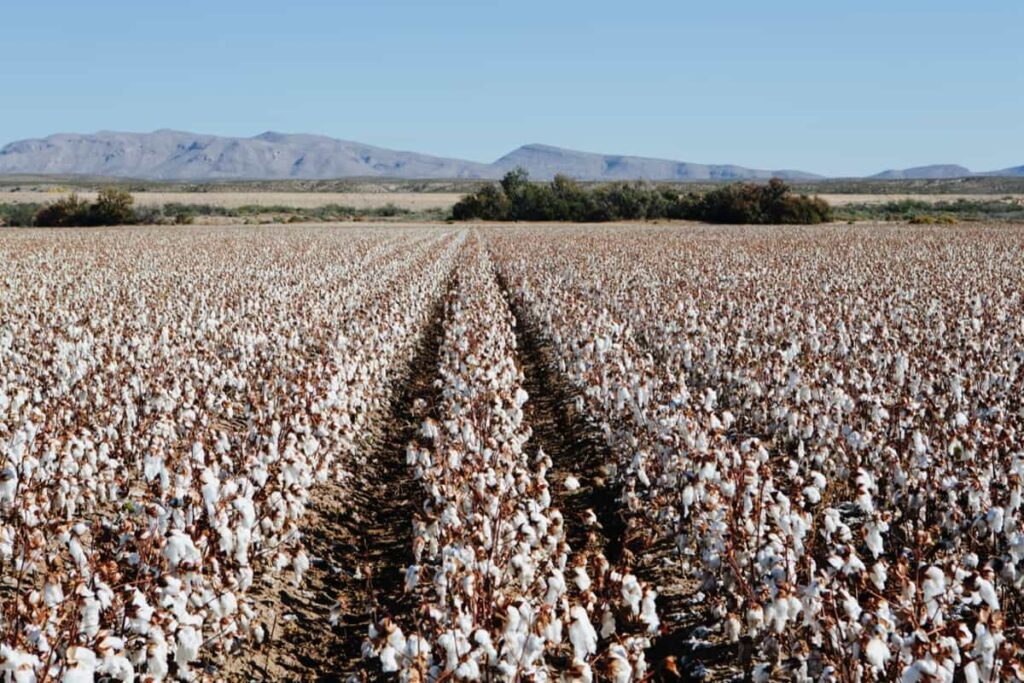
Biological Management
Biological management uses mass-produced bioagents to complement Integrated Pest Management (IPM) and reduce reliance on chemical insecticides. Examples include Trichogrammachilonis, Braconbrevicornis, and T.chilonis Bio C1 or C3 in cotton pest management. These agents target specific cotton pests like spotted bollworms and pink bollworms. They are released at specific intervals, ensuring continuous pest control throughout the cotton crop’s growth stages.
Chemical Pest Control in Cotton Farming
- Targeted Approach: In areas where the Helicoverpa armigera (American bollworm) poses a significant threat and has developed resistance to conventional control methods, efficient insecticide strategies are employed.
- Insecticide Resistance Management: A strong emphasis is placed on managing insecticide resistance, as overreliance on a single insecticide can develop resistance in pest populations.
- Sucking Pest-Tolerant Genotypes: When resistance levels are relatively low (up to 90 days after sowing), a recommended strategy is to cultivate cotton genotypes tolerant to sucking pests. This tolerance allows for a “no-spray” situation for 60 days.
- Sequential Insecticide Sequence: As the cotton crop progresses, a well-planned sequence of insecticides is deployed. This sequence may include bio-rational insecticides like HaNPV (Helicoverpa armigera nucleopolyhedrovirus), Bt (Bacillus thuringiensis), and neem-based products.
- Timing Based on Economic Thresholds: The choice of insecticides are based on the economic thresholds of pest populations. Organophosphorus insecticides and pyrethroids are recommended at specific intervals, typically at 80-90, 90-110, and 110-130 days of crop growth.
- Precise Application: Insecticide use is restricted to specific windows associated with crop development stages. This targeted approach minimizes the environmental impact and maximizes the effectiveness of chemical pest control.
Preventing Pest Resistance through Integrated Pest Management
- Diverse Techniques: IPM encompasses various techniques, including biological control, habitat manipulation, cultural practices modification (such as tillage methods), and the use of pest-resistant cotton varieties.
- Reduced Pesticide Use: IPM prioritizes methods other than pesticides as the first line of defense against pests. It aims to manage pests efficiently and economically while minimizing pesticide application.
- IPM Methods:
- Prevent: Strategies are employed to keep pest populations from infesting cotton fields.
- Avoid: Cultural measures are implemented to mitigate or eliminate damage caused by pests.
- Monitor: Systematic field scouting is carried out to detect and identify pests.
- Suppress: Existing pest populations are controlled or reduced to minimize crop damage.
Ongoing Research: The cotton industry, universities, and the USDA are actively researching to advance IPM practices. In 2022, numerous entomology research projects across 16 states aimed to enhance IPM strategies.
Weed Management: Developing new weed management techniques is essential for sustainable agriculture. Projects focus on cultural, chemical, and biological approaches to control weeds without resorting to excessive tillage.
Pest-Resistant Cotton Varieties: Some cotton varieties are bred to resist insects and pathogens, reducing the need for pesticides. Herbicide-tolerant cotton allows growers to move towards conservation tillage, benefiting soil health and reducing greenhouse gas emissions.
Global Impact: U.S. cotton growers are at the forefront of advanced pest management strategies, sharing knowledge worldwide. These practices enhance grower profitability, cotton quality, and environmental sustainability.
In case you missed it: Boosting Crop Yields and Income: A Guide to Greenhouse Farming in Tanzania
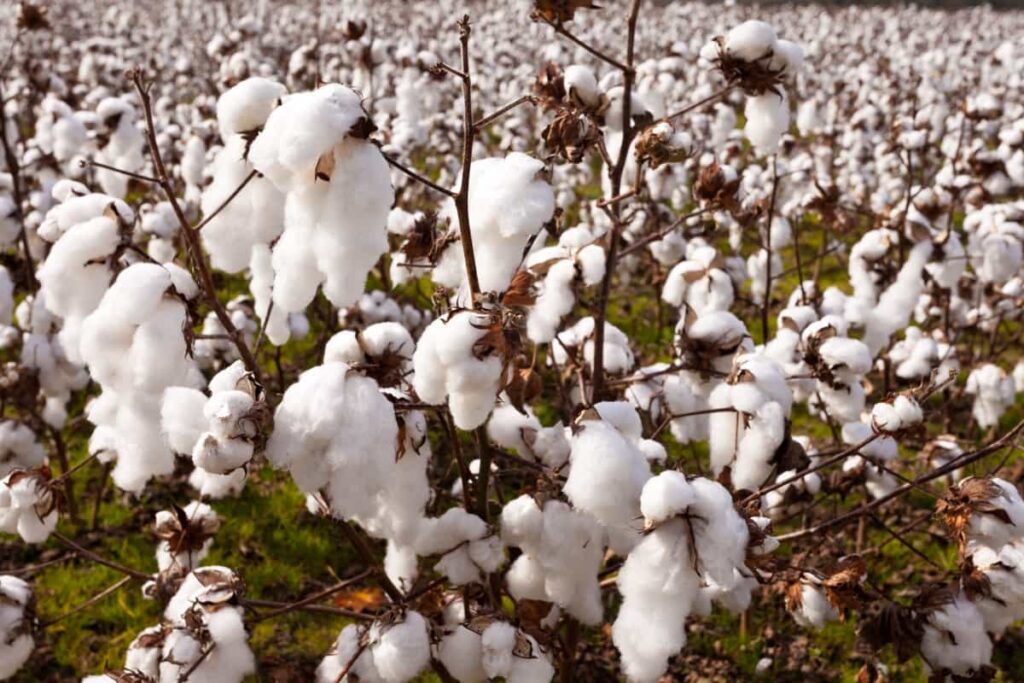
Monitoring and Early Detection
- Scouting: Regular field inspections to detect pest presence and assess population levels.
- Traps and Monitoring Tools: Use specialized traps, pheromones, or sensors to monitor pest activity.
- Data Collection: Gathering data on pest species, population dynamics, and distribution.
- Threshold Levels: Establishing economic threshold levels to determine when intervention is necessary.
- Remote Sensing: Utilizing technology like drones or satellite imagery for large-scale monitoring.
- Weather Data: Analyzing weather patterns to predict pest outbreaks.
Tips for Successful Cotton Pest Management
Cotton cultivation faces challenges from various pests, including jassids, aphids, whiteflies, thrips, and bollworms. Implementing effective pest management strategies is crucial for a successful cotton crop.
- Early Detection: Regularly monitor fields for pest presence, especially during the early growth stages, to detect and address issues promptly.
- Integrated Pest Management (IPM): Adopt IPM practices that encompass biological control, cultural methods, and pest-resistant cotton varieties. IPM prioritizes sustainable pest control with minimal pesticide use.
- Sucking Pest Awareness: Recognize the threat of sucking pests like jassids, aphids, and whiteflies, which can lead to poor crop stands and yield reduction.
- Late-Season Vigilance: Be aware of late-season pest attacks, particularly by aphids and whiteflies, which can impact cotton fiber quality due to honeydew deposits and the spread of diseases.
- Bollworm Complex Management: Implement measures to control the bollworm complex, including Earias, Helicoverpa, and Pectinophora species. These pests affect the reproductive phase of cotton growth.
- Cultural Control: Practices such as crop rotation, timely cotton planting, and spacing of varieties can aid in pest management.
- Biological Control: Utilize natural predators like Chilomenessexmaculatus and Chrysoperlacarnea to control early-season sucking pests. Protect these predators by reducing broad-spectrum insecticide use.
- Host Plant Resistance: To minimize damage, Choose cotton cultivars resistant to specific pests like jassids, aphids, and bollworms.
- Botanical Management: Explore botanical solutions like neem extracts to deter sucking pests and bollworms. Research and testing are essential before widespread adoption.
- Chemical Control: In areas with significant pest resistance, follow recommended insecticide sequences based on economic thresholds and crop development stages to optimize control while minimizing environmental impact.
In case you missed it: Canada Greenhouse Farming: How to Start for Profits, Crop Selection, and Sustainable Practices
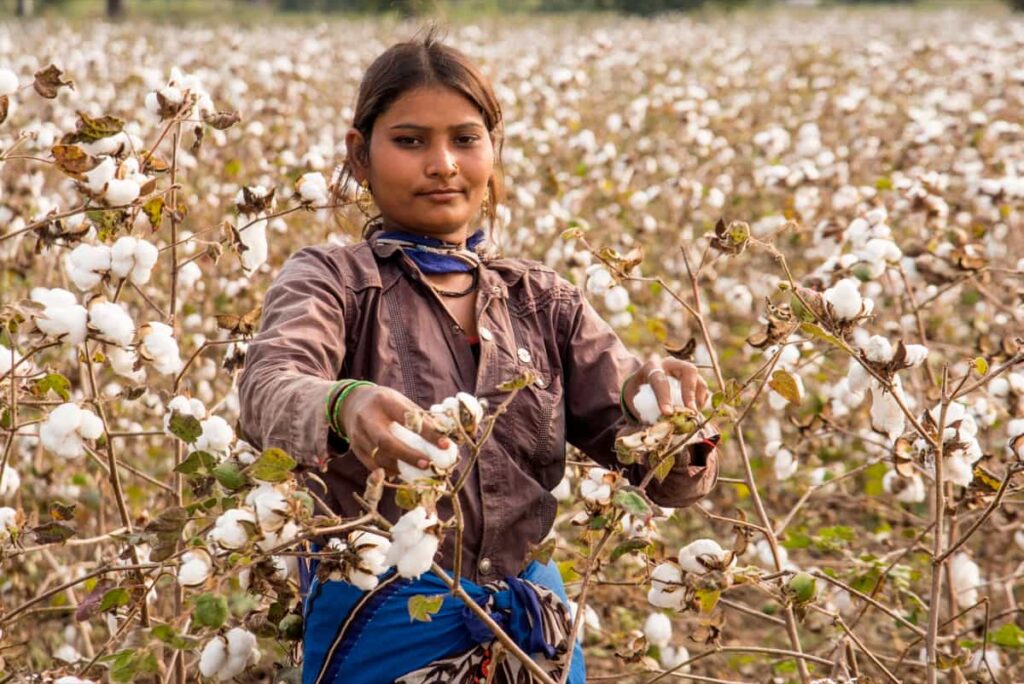
Conclusion
Successful pest management in cotton farming is essential for crop productivity and sustainability. Implementing integrated pest management (IPM) practices, early detection, and a combination of biological, cultural, and chemical control measures are crucial for minimizing pest damage while reducing the environmental impact of cotton cultivation.
- Management Pests and Diseases in Your Cotton Field
- Sheep Farming Business Plan for Beginners
- Aquaponic Farming at Home: A Step-By-Step Guide
- Profitable Village Farming Business Ideas in 2024
- High-Yield Aquaculture: Fast-Growing Fish for Farming
- Effective Fish Pond Construction Techniques for Beginners
- Irrigation and Water Management in Pineapple Farming
- Blossom to Harvest: Mastering Flowering and Pollination in Papaya Farming
- Pig Fattening Essentials: From Selection to Sale for Beginners
- Raising Wagyu Cattle: A Complete Guide for Premium Beef Production
- Soil Types and Their Water Holding Capacity
- Optimizing Irrigation Schedules for Coconut Groves for Enhanced Yield
- Espresso Your Garden: Coffee Grounds for Healthier Acid-Loving Plants
- The Best Soil Mix for Snake Plants: How to Mix Your Own Snake Plant Soil
- Green Thumb Success: Expert Tips for Cultivating Greenhouse Beans All Year Round
- Bloom All Year Round: The Ultimate Guide to Indoor Hyacinth Care
- Eco-Friendly Gardening: How to Make Liquid Fertilizer from Kitchen Waste
- Ultimate Guide to Grow Anise in Pots: Explore Seed Propagation to Harvesting
- Guide to Raising Chester White Pigs: Discover Breed Facts to Growth Management
- Mastering the Elegance: The Ultimate Guide to Weeping Cherry Tree Care, Planting, and Maintenance
- Ultimate Guide to Planting Garlic in Grow Bags: Growing Strategies for Beginners
- How to Fix Spider Plant Leaf-Related Problems: Natural and Organic Remedies
- 10 Reasons Why Your Tulsi Plant is Shedding Leaves: Home Remedies and Solutions
- Optimizing Growth and Yield: The Advantages of Palm Bunch Ash Fertilizer
- Utilizing Neem Oil Extract as a Natural Pesticide for Hydrangea
- From Soil to Harvest: Various Ways in Which Farmers Can Use AI Tools
- Steps to Encourage and Induce Citrus Flowers: A Comprehensive Guide
- How to Fix Snake Plant Leaf-Related Issues: Natural and Organic Remedies
- Transform Your Garden into a Fragrant Oasis with Raat Ki Rani (Night Blooming Jasmine)
- Discover the Ideal Chicken Breeds for Philippine Farms
- How to Create a Poultry Egg Farm Business Plan for Profits
- Grow Lemon Cucumbers Like a Pro: Insider Techniques for Bountiful Yields
- Ultimate Guide to Caring for Your Pink Princess Philodendron: Tips for Thriving Variegation
- Areca Nut Profit Per Acre: Calculating Yield and Cost of Cultivation
- How Kaveri Chicken is Becoming a More Profitable Breed in Indian Backyards
- Transform Your Barn: 9 Steps to Convert a Horse Stall into a Chicken Coop
